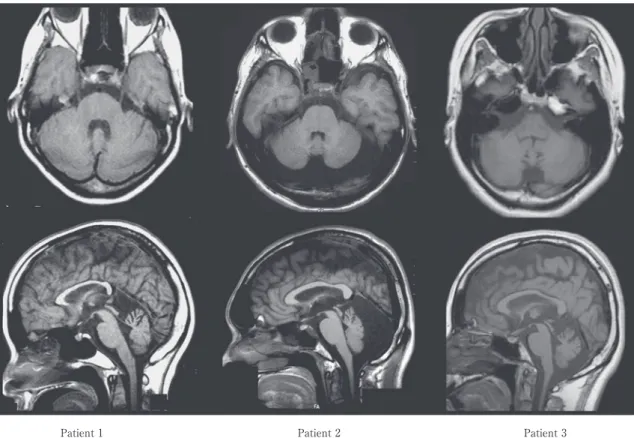51:1125
<シンポジウム 29―3>脊髄小脳変性症 update
わが国における遺伝性痙性対麻痺の現状
瀧山 嘉久
要旨:Japan Spastic Paraplegia Research Consortium(JASPAC)の網羅的な遺伝子解析結果から本邦の遺伝性 痙性対麻痺(Hereditary Spastic Paraplegia:HSP)の分子疫学の outline が判明した.ADHSP では半数近くを SPG4 が占めていたが,約 4 割で病型が特定できなかった.ARHSP では SPG11 と ARSACS の頻度が高かったが, 約 8 割で病型が特定できなかった.病型が特定できなかった HSP のうち,視神経萎縮と末梢神経障害を呈する ARHSP について,新規原因遺伝子の探索が進行中である. (臨床神経 2011;51:1125-1128) Key words:遺伝性痙性対麻痺,JASPAC,ARSACS,MRI,遺伝子解析 1.はじめに
遺 伝 性 痙 性 対 麻 痺(Hereditary Spastic Paraplegia: HSP)は,緩徐進行性の下肢痙縮と筋力低下を主徴とする神経 変性疾患群である1)2).常染色体優性遺伝性(ADHSP),常染 色体劣性遺伝性(ARHSP),X 連鎖性劣性遺伝性(XRHSP)に 分類されるが,これまでに SPG1∼48 の遺伝子座が判明し,20 を越える原因遺伝子が同定されている. 本邦 HSP に関する疫学調査は少なく,人口 10 万人あたり 約 0.2 人の有病率であると推定されている3).特定疾患臨床調 査個人票の解析では 10,487 名の脊髄小脳変性症患者の 4.7% を占めるとされているが4),詳細な分子疫学は不明のままで あった.
本稿では,Japan Spastic Paraplegia Research Consortium (JASPAC)による本邦 HSP の分子疫学の現状,Charlevoix-Saguenay 型痙性失調症(ARSACS)の臨床像の特徴,そして HSP の新規原因遺伝子探索の動きを紹介する. 2.本邦 HSP の分子疫学 JASPAC では,全国的なゲノムリソースの収集をおこな い,大規模ゲノム解析により遺伝子診断サービスを提供する と共に,本邦 HSP の分子疫学と自然歴を明らかにすること, HSP の病態機序の解明と治療法の開発を目指している. 2011 年 7 月 20 日 現 在,全 国 42 都 道 府 県,140 施 設 か ら HSP 375 家系が登録され,index patient 275 検体が集められ ている.これらの検体について,東京大学神経内科で網羅的遺 伝子解析が,自治医科大学神経内科で SACS 遺伝子解析がお こなわれている5)6). ADHSP 148 家系中,SPG4(47%),SPG31(4%),SPG3A (3%),SPG8(1%),SPG10(1%)であり,欧米と同様に本 邦でも SPG4 が半数近くを占めていた.また,既知の遺伝子変 異をみとめない家系が 44% であった.ARHSP 20 家系中, SPG11 が 10%,ARSACS が 5% であった.わずか 15% しか 遺伝子型が決定できず,85% では既知の遺伝子変異をみとめ なかった.ARHSP がうたがわれる(孤発例で両親に血族婚あ り)22 例では SPG11 が 3 例存在し,偶然に SPG4 が 1 例みい だされたが, 82% では既知の遺伝子変異をみとめなかった. 遺伝形式が特定できない 37 家系では,SPG11(8%),SPG4 (5%),SPG3A(3%),ALD!AMN(3%)であり,残り 81% では遺伝子型が同定できなかった.孤発 75 例中,SPG4(5%), SPG3A(1%),ARSACS(1%)であり,孤発例の中にも HSP がふくまれていた(以上の解析データは JASPAC 検体に加え て,東京大学神経内科が独自に集めた検体による5)6)).既知の 遺伝子変異をみとめない家系について,今後,新規原因遺伝子 の同定が望まれる. 3.ARSACS
Autosomal recessive spastic ataxia of Charlevoix-Saguenay(ARSACS)は,カナダ ケベック州のシャルルヴォ ア・サグネ地方に伝わる遺伝性痙性失調症としてはじめて報 告された.しかし,SACS 遺伝子が同定されてからは,チュニ ジア,イタリア,トルコ,スペイン,フランス,ベルギー,オ ランダ,ドイツ,モロッコなど,世界的に本疾患が存在するこ とが明らかになっている. 2004 年,筆者らは本邦にも SACS 遺伝子変異をもつ家系が 存在することをはじめて報告し7),その後,計本邦 10 家系を 経験している.臨床的には,本邦例では,ケベック例(1∼1.5 歳)に比し発症年齢は遅く(平均 6.3 歳),下肢の痙縮や腱反 射亢進を欠く例,網膜有髄線維の増生をみとめない例,知能低 下を呈する例があることなど,臨床的に多様性があることが 判明した7).SACS 遺伝子解析では,巨大エクソンの private mutation の他,上流のエクソンにも変異をみいだしている7). 頭部 MRI では,小脳虫部上葉の萎縮が特 徴 的 で あ り, 山梨大学大学院医学工学総合研究部神経内科学講座〔〒409―3898 山梨県中央市下河東 1110〕 (受付日:2011 年 5 月 20 日)
臨床神経学 51巻11号(2011:11) 51:1126
Fig. 1 Representative brain MRI findings (T1 weighted). Axial (upper) and sagittal (lower) slices
in three patients with ARSACS. In these patients, cerebellar atrophy, especially in the upper vermis, can be seen. In addition, a megacisterna magna (patient 2) and cervical atrophy (patients 2 and 3) can be noted.
Patient 1 Patient 2 Patient 3
Fig. 2 Representative brain MRI findings (T2 weighted). Axial slices in three patients with
ARSACS. In these patients, linear hypointensities in the pons (arrowheads) and a hypointensity area in the bilateral middle cerebellar peduncles (arrows) can be seen. These findings could be specific for ARSACS8).
Patient 1 Patient 2 Patient 3
megacisterna magna や頸髄萎縮をみとめる例もある(Fig. 1).最近筆者らは,SACS 遺伝子変異を持つ 8 名の患者全員 に,T2強調像・FLAIR 像で橋と中小脳脚の線状低信号(Fig.
2)をみとめることをみいだしたが8),この所見は小脳虫部上
わが国における遺伝性痙性対麻痺の現状 51:1127 4.新規原因遺伝子の同定へ向けて 筆者らは,視神経萎縮と末梢神経障害をともなう ARHSP 家系(両親がいとこ婚,同胞 2 名が発症)9)について,新規原因 遺伝子の同定を試みた10).まず,SNP をもちいた連鎖解析(ホ モ接合体マッピング)をおこなったところ,第 2,6,12,13 の 4 つの染色体上に lod 値の高い場所があり,候補領域である と考えられた.この領域には既報の HSP 遺伝子座はふくまれ ておらず,アレイ CGH による検討では,病的遺伝子コピー数 異常をみとめなかった. 次に,患者 1 名につき,次世代シーケンサーによるエクソー ム解析をおこなった.その結果,第 12 番染色体の候補遺伝子 内に 3 つの新規アミノ酸置換をともなう変異をホモ接合体で 同定した.このうち 1 つの遺伝子ではナンセンス変異をみと めており,直接塩基決定法でもこの変異は確かめられた.さら に,発症している兄弟にも同じ変異を確認している.現在, もっとも有力な候補遺伝子として,その機能解析をおこなっ ているところである. 5.おわりに 今後,幅広い研究者が JASPAC のリソースを利用すること により,HSP の分子病態が解明され,根本的な治療法が開発 されることが望まれる. 謝辞:JASPAC にご協力いただいた全国の患者さんと先生方に 感謝いたします.共同研究者の自治医科大学神経内科 嶋崎晴雄 先生,滑川道人先生,迫江公己先生,直井為任先生,中野今治先生, 本多純子さん,太田京子さん,東京大学神経内科 石浦浩之先生, 福田陽子先生,高橋祐二先生,後藤 順先生,辻 省次先生,新潟 大学神経内科 西澤正豊先生,北海道大学神経内科 佐々木秀直 先生に感謝いたします. 文 献
1)McDermott CJ, Shaw PJ. Hereditary spastic paraplegia. In: Eisen AA, Shaw PJ, editors. Handbook of Clinical Neu-rology, Vol. 82, Motor neuron disorders and related dis-eases. Amsterdam: Elsevier Science; 2007. p. 327-352. 2)瀧山嘉久. 遺伝性痙性対麻痺. 柳澤信夫, 篠原幸人, 岩田
誠 ら, 編. Annual Review神経. 東京: 中外医学社; 2008. p. 198-211.
3)Hirayama K, Takayanagi T, Nakamura R, et al. Spi-nocerebellar degenerations in Japan: a nationwide epide-miological and clinical study. Acta Neurol Scand 1994;153: 1-22.
4)Tsuji S, Onodera O, Goto J, et al. Sporadic ataxias in Ja-pan: a population-based epidemiological study. Cerebel-lum 2008;7:189-197. 5)瀧山嘉久, 石浦浩之, 嶋崎晴雄ら. 本邦の痙性対麻痺に関す る全国多施設共同研究体制(JASPAC).臨床神経 2010;50: 931-933. 6)瀧山嘉久, 石浦浩之, 嶋崎晴雄ら. 遺伝性痙性対麻痺の疫 学:JASPAC. 神経内科 2011;74:141-145.
7)Takiyama Y. Sacsinopathies: sacsin-related ataxia. Cere-bellum 2007;6:353-359.
8)Shimazaki H, Takiyama Y, Honda J, et al. Middle cerebel-lar peduncles and pontine T 2 hypointensities in AR-SACS. J Neuroimaging (in press).
9)城下 裕, 渥美哲至, 宮武 正. Spastic paraplegia, optic at-rophy, peripheral neuropathy を呈した 2 同胞例. 臨床 神 経 1982;22:901-908. 10)瀧山嘉久, 嶋崎晴雄, 本多純子ら. 視神経萎縮,末梢神経障 害を伴う遺伝性痙性対麻痺症例の臨床像と原因遺伝子検 索. 厚生労働省 難病性疾患克服研究事業,運動失調に関 する調査及び病態機序に関する研究班,平成 22 年度研究 報告書. 2011. p. 101-103.
臨床神経学 51巻11号(2011:11) 51:1128
Abstract
Hereditary spastic paraplegia in Japan
Yoshihisa Takiyama, M.D.
Department of Neurology, Interdisciplinary Graduate School of Medicine and Engineering, University of Yamanashi The Japan Spastic Paraplegia Research Consortium (JASPAC) is conducting a nationwide clinical and genetic survey of patients with HSP in Japan. To date (July 20, 2011), 375 index patients with HSP from 42 prefectures in Japan have been registered. In 148 Japanese ADHSP families, SPG4 was the most common form, accounting for 47%, followed by SPG31 (4%), SPG3A (3%), SPG8 (1%), and SPG10 (1%). Meanwhile, preliminary data showed that SPG 11 and ARSACS were common in Japanese ARHSP families. Since the genes in approximately 40% of ADHSP and 80% of ARHSP cases remain unknown, we aim to identify the new genes responsible for HSP. We are now searching for a novel gene responsible for ARHSP with optic atrophy and neuropathy.
To date, non-Quebec patients with ARSACS have been found in the Mediterranean area, Europe and Japan. Although Quebec patients show a homogeneous phenotype, Japanese patients exhibit some atypical clinical fea-tures, as follows: slightly later onset than that in Quebec patients, absence of retinal hypermyelination, intellectual impairment, and lack of spasticity. Recently, we found characteristic MRI findings in eight Japanese ARSACS pa-tients, who all exhibited linear hypointensity in the pons and a hypointense area in the middle cerebellar pedun-cles in T2weighted and FLAIR images.
(Clin Neurol 2011;51:1125-1128)
